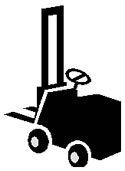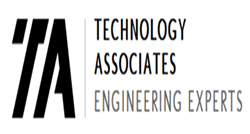 Forklifts, industrial trucks, skid steer loaders, bobcats and other similar material-handling machines are often difficult to maneuver and susceptible to a wide range of accidents. Their nature exposes operators and nearby co-workers to falling loads, crushing hazards and lading dock falls. Large loads and high centers of gravity also make these machines prone to tip-over accidents. To mitigate some of these dangers, machines are usually equipped with Roll Over Protective Structures (ROPS), Falling Object Protective Structures (FOPR) and other forms of guarding. Machine speed and braking acceleration is often controlled electronically to reduce the likelihood of a tip-over.
Forklifts, industrial trucks, skid steer loaders, bobcats and other similar material-handling machines are often difficult to maneuver and susceptible to a wide range of accidents. Their nature exposes operators and nearby co-workers to falling loads, crushing hazards and lading dock falls. Large loads and high centers of gravity also make these machines prone to tip-over accidents. To mitigate some of these dangers, machines are usually equipped with Roll Over Protective Structures (ROPS), Falling Object Protective Structures (FOPR) and other forms of guarding. Machine speed and braking acceleration is often controlled electronically to reduce the likelihood of a tip-over.
Expertise
At Technology Associates our testing, research and analysis capabilities include:
- Stability analysis
- Component failure
- Brake testing
- Operator biomechanics
Questions Answered
Through scientific analysis, we can help you answer pertinent questions such as:
- Why did the forklift tip-over?
- Did the machine's guarding meet applicable safety standards?
- Why did the load fall on the operator?
- Were they any safety devices available at the time the machine was built that could have prevented the accident or mitigated injuries?
Case Examples
Missing Locking Pin:
A forklift operator was lifting a large load while an assistant was standing nearby observing the operation. Suddenly, one fork shifted its position and caused the load to fall onto the assistant, causing a severe crush injury. Upon inspection of the machine, Technology Associates identified a missing fork locking pin, which allowed the fork to move unexpectedly and caused the accident, indicating that the accident was the result of improper maintenance.
Forklift Intrusion:
The driver of an upright lift truck crashed into a metal railing when the truck's brakes malfunctioned. The broken railing intruded into operator compartment causing serious leg injuries. We created a biomechanical model to show that the intruding railing caused the injury, as opposed to the defense's claim that the operator stuck her foot out. We also showed that a door would have been an appropriate safety device that would have prevented her injuries, resulting in a substantial jury award.
Kristopher J. Seluga, PE, is a Mechanical Engineering, Accident Reconstruction, Biomechanics, and Safety Expert with over 20 years of experience. He received his Bachelor's and Master's degrees from the Mechanical Engineering department at MIT where he worked on the development of novel three-dimensional printing technologies. Mr. Seluga is also a licensed Professional Engineer in New York and Connecticut, and has served as a member of the ANSI engineering committee for the Z130.1 and Z135 standards for golf cars and PTV's. His research interests and peer reviewed publications span the topics of Motor Vehicle Dynamics, Product Safety, and Biomechanics.
©Copyright - All Rights Reserved
DO NOT REPRODUCE WITHOUT WRITTEN PERMISSION BY AUTHOR.



 Forklifts, industrial trucks, skid steer loaders, bobcats and other similar material-handling machines are often difficult to maneuver and susceptible to a wide range of accidents. Their nature exposes operators and nearby co-workers to falling loads, crushing hazards and lading dock falls. Large loads and high centers of gravity also make these machines prone to tip-over accidents. To mitigate some of these dangers, machines are usually equipped with Roll Over Protective Structures (ROPS), Falling Object Protective Structures (FOPR) and other forms of guarding. Machine speed and braking acceleration is often controlled electronically to reduce the likelihood of a tip-over.
Forklifts, industrial trucks, skid steer loaders, bobcats and other similar material-handling machines are often difficult to maneuver and susceptible to a wide range of accidents. Their nature exposes operators and nearby co-workers to falling loads, crushing hazards and lading dock falls. Large loads and high centers of gravity also make these machines prone to tip-over accidents. To mitigate some of these dangers, machines are usually equipped with Roll Over Protective Structures (ROPS), Falling Object Protective Structures (FOPR) and other forms of guarding. Machine speed and braking acceleration is often controlled electronically to reduce the likelihood of a tip-over.







